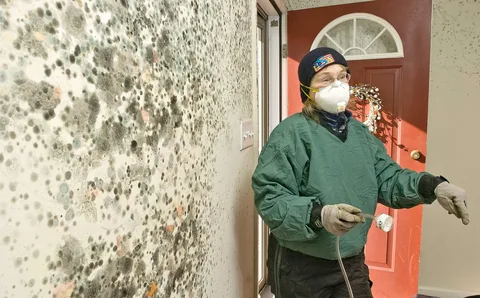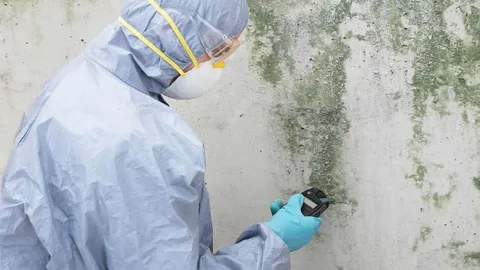Tackling mould issues is essential for maintaining a healthy living or working environment. Mould threatens the structural integrity of buildings and can have serious implications for human health. Investing in professional mould inspection Sydney services is crucial to ensure early detection and effective intervention. You can effectively combat mould threats by understanding the significance of mould, the role of professional services, and how to prepare for a mould inspection.
Understanding the Significance of Mould in Our Environment
Mould, a ubiquitous fungus, finds its way into our homes and workplaces, thriving in moist and humid conditions. Its presence is not merely a cosmetic concern but has deeper structural integrity and health implications. As mould spores settle on damp surfaces, they begin to increase, forming colonies that can damage building materials and belongings. Beyond the physical damage, the spores released into the air pose significant health risks, particularly for those with allergies, asthma, or compromised immune systems.
Recognizing mold’s ecological role is crucial; while it breaks down organic matter outdoors and indoors, it becomes a contaminant that must be controlled. Its ability to grow rapidly under favorable conditions underscores the need for vigilance and timely intervention to prevent its spread. Understanding the environmental conditions that foster mould growth is the first step in creating strategies to mitigate its impact on our surroundings and well-being.
The Role of Professional Mould Inspection Services
Professional mould inspection services are essential for identifying and managing mould concerns in residential and commercial settings. Experienced professionals with advanced tools conduct these inspections to identify visible mould growths and hidden infestations lurking behind walls or under floors. These experts conduct comprehensive evaluations, enabling them to offer precise assessments alongside recommendations for effective remediation strategies.
Their in-depth knowledge of mould types, growth patterns, and health implications ensures they can advise on the best action, tailoring solutions to each unique scenario. Furthermore, these specialists understand the conditions that encourage mould growth, allowing them to provide advice on preventing future issues. Engaging professional mould inspection services ensures a meticulous and informed approach to mould management, which is essential for maintaining a healthy and safe environment.
Identifying Mould: Signs and Symptoms to Watch For
Identifying the presence of mould in your environment is not always straightforward, especially when it comes to those strains that aren’t immediately visible. However, a keen observation of certain indicators can signal an underlying mould issue. A musty odor is one of the most recognizable signs, often pervading the area long before the mould becomes visually apparent. Discoloration on surfaces such as walls or ceilings, ranging from black and green to white patches, may also suggest mould growth. These visual cues are critical, as they typically denote areas where moisture has accumulated, providing a fertile breeding ground for mould.
Moreover, health symptoms experienced by the occupants can serve as vital clues. Respiratory problems, including increased coughing, wheezing, or difficulty breathing, are commonly reported among individuals exposed to mould. Those with pre-existing allergies or asthma may find their conditions exacerbated in a mould-infested environment. Persistent irritation of the eyes, nose, throat, or skin can also indicate mould exposure. It’s important to be vigilant of these signs and symptoms, as they highlight a potential mould problem and underscore the urgency of addressing it to safeguard health and wellbeing.
The Process of Professional Mold Inspection Sydney
A professional mold inspection Sydney involves a systematic and detailed examination of the property to locate any signs of mould growth and identify potential moisture sources that could contribute to future issues. Initially, the inspection begins with visually assessing accessible areas to spot any visible mould or water damage. Following this, the inspector may utilize specialized equipment such as moisture meters, thermal imaging cameras, and bore scopes to detect hidden problems behind walls, under floors, or ceilings. Air and surface samples may also be collected for laboratory analysis to determine the types of mould present and the concentration of spores in the air, providing a clearer picture of the indoor air quality.
The inspector will review the building’s history, considering any known water incidents or areas prone to dampness. Based on these findings, a comprehensive report is generated detailing the extent of the mould issue, the health risks associated with the identified mould types, and recommendations for remediation and moisture management to prevent recurrence. Engaging with a professional service ensures a thorough approach, uncovering not just the symptoms but the source of mould growth, which is essential for effective management and prevention.
Benefits of Early Mould Detection and Intervention
Identifying and addressing mould growth at the earliest opportunity offers several advantages:
- It significantly reduces the likelihood of extensive property damage. Left unchecked, mould can infiltrate building materials, leading to costly repairs and replacements. Early intervention halts this process, preserving the integrity of the property and its contents.
- Early detection minimizes health risks associated with mould exposure. By promptly eliminating mould, occupants’ risk of respiratory issues, allergic reactions, and other health problems is greatly lowered. This proactive approach enhances the overall air quality and contributes to a safer, more comfortable living or working environment.
- Early mould management can lead to financial savings. Addressing mould issues before they escalate can avoid the need for more extensive remediation efforts, which are often time-consuming and expensive.
- Maintaining a mould-free environment can enhance property value, as it signals well-maintained premises to potential buyers or tenants.
The benefits of early mould detection and intervention are manifold, encompassing health, financial, and structural advantages, making it a wise investment for property owners and managers.
How to Get the Free Mould Inspection Sydney?
Securing a free mould inspection Sydney is a proactive step towards maintaining a healthy environment in your property. Many reputable mould inspection companies offer an initial consultation at no cost to evaluate the extent of mould issues and propose appropriate solutions. To take advantage of this opportunity:
- Start by researching and identifying well-reviewed mould inspection services in the Sydney area.
- Once you have shortlisted potential providers, contact them directly via their contact information on their website or social media platforms.
- When scheduling your free inspection, be prepared to describe any visible mould growth, areas of concern, or symptoms of mould exposure you have noticed. This information will assist the inspectors in their preliminary assessment.
It’s also advisable to enquire about the scope of the free inspection to understand what it entails, ensuring you have a clear picture of the process. Engaging with professional services for a complimentary assessment can pave the way for effective mould management, giving you peace of mind and a healthier indoor environment.
Preparing Your Home or Office for a Mould Inspection
Getting your property ready for a mould inspection is a critical step in ensuring the effectiveness of the assessment. Clearing the premises of clutter and personal items facilitates easy access for the inspectors and allows for a more comprehensive evaluation of your space. Attention is given to areas where mould is suspected or where moisture accumulation is common, such as bathrooms, kitchens, and basements. Ensure that furniture is moved away from walls and that any storage areas are easily accessible.
If you have noticed any specific spots where mould growth is visible or regions subject to water damage, make a note to inform the inspectors upon their arrival. Additionally, maintaining a list of symptoms or concerns experienced by the inhabitants can be invaluable in guiding the inspection process. Ventilation systems should also be made accessible for a thorough inspection, as mould spores can often circulate through HVAC systems, spreading to different parts of the property.
By taking these preparatory steps, you not only assist in the detection process but also contribute to the overall efficiency of the inspection, ensuring that no area is overlooked and that you receive the most accurate assessment possible.
Mould Remediation: Next Steps after Inspection
Upon receiving the results of a professional mould inspection, initiating remediation actions is crucial for restoring a healthy environment. The specific remediation approach will vary and be tailored to the severity and location of the mould infestation, as detailed in the inspection report. Typically, this involves meticulously removing mould-affected materials, such as plasterboard or insulation that cannot be salvaged. In addition, thorough cleaning and disinfecting of the area are necessary to eliminate residual spores.
Improving ventilation within the property plays a vital role in mitigating moisture accumulation, a primary catalyst for mould growth. This might entail installing or upgrading extractor fans and dehumidifiers and ensuring that HVAC systems are properly serviced to maintain optimal air quality. For areas prone to dampness, strategies such as redirecting water away from the building’s foundation and sealing leaks can provide long-term solutions to prevent reoccurrence.
Engaging professionals in the remediation process is advisable, as they possess the expertise and equipment to eradicate mould safely and effectively. Following the remedial actions, a post-remediation inspection is recommended to confirm that the environment is mould-free and the initial issues have been adequately addressed, maintaining the property’s safety and integrity.
Conclusion
Addressing mould concerns is not merely about remediation but involves a holistic approach encompassing early detection, precise intervention, and the implementation of preventative measures. Professional mould inspection Sydney services stand at the forefront of this battle, offering the expertise and technology necessary to uncover and tackle mould at its source. Engaging these services provides peace of mind, knowing that the health risks and structural damages associated with mould can be mitigated effectively. Embracing professional support in this endeavor ensures a thorough and effective approach to mould control, laying the foundation for a safer, cleaner living and working environment.
FAQs
Q: How frequently is a mould inspection necessary?
A: Scheduling a mould inspection on an annual basis is advisable, particularly for those residing in areas with high humidity levels or in properties that have been affected by water-related incidents. Regular inspections help in early detection and mitigation of potential mould issues.
Q: Is it possible to conduct a mould inspection by oneself?
A: Although there are DIY mould testing kits on the market, enlisting the services of professional mould inspectors is highly recommended for comprehensive and dependable outcomes. Professionals are equipped with specialized tools and possess the expertise to accurately identify and assess mould issues.
Q: What is the duration of a typical mould inspection Sydney?
A: The time required to complete a mould inspection Sydney can vary significantly, influenced by factors such as the property’s size and the severity of the mould problem. Generally, a thorough examination could last from a couple of hours to an entire day for larger or more complex properties.
Q: Are there immediate steps I should take if I suspect mould growth in my home?
A: If you notice signs of mould, such as musty smells or visible growth, promptly contacting professional mould inspection services is crucial. They can provide an accurate assessment and recommend appropriate remedial actions to address the issue effectively. Additionally, maintaining good ventilation and addressing any moisture sources can help mitigate the problem temporarily until professional help is received.
Q: Can mould return after professional remediation?
A: Mould can recur if the underlying causes of moisture and dampness are not adequately addressed. Post-remediation, it’s essential to follow professional advice on maintaining a dry and well-ventilated environment to prevent mould from returning. Regular inspections also play a critical role in monitoring and maintaining a mould-free property.
| Other Good Articles to Read |
| Blogs-Nation |
| Blogs-Peoples |
| Bryan Smith Blogs |
| intellect blogs |
| the fault in our blogs |
| blogs eu |
| oz forums |
| recruitment blogs |
| zet blogs |
| id blogs |
| Blog Studio legale |
| blogs map |
| Related Business Listings |
| Contact Directory |
| Local Business Profiles |



